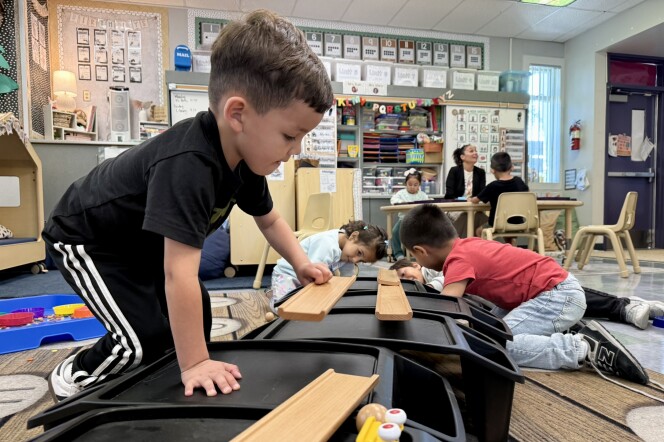Truth matters. Community matters. Your support makes both possible. LAist is one of the few places where news remains independent and free from political and corporate influence. Stand up for truth and for LAist. Make your year-end tax-deductible gift now.
First mural of its kind unveiled at a mosque in Koreatown. Here's what makes it special

A sabbaar — the Arabic name for a prickly pear cactus — is at the heart of a new first-of-its-kind mural unveiled at the Islamic Center of Southern California on Monday.
The unveiling comes a month after the mosque in Koreatown was targeted with hate-motivated graffiti.
Named Sabr at Fajr, the mural by artist Saj Issa captures the themes of patience, endurance and resilience and celebrates the cultural ties between Los Angeles, especially its Latino community and the Middle East. Sabr in Arabic loosely translates to patience while Fajr is the first prayer of the day for Muslims. And the Arabic word for cactus, sabbaar, also traces back to the word for patience.
“It's not just a painting, it represents so much more,” said Robin Toma, executive director of Los Angeles County’s Commission on Human Relations. “That tells us how this is a community that has suffered so much targeting for hate and prejudice and discrimination, and that at the same time, this is such an amazing opportunity for expression of community, of inclusion and belonging.”
Funding for the mural comes in part from the commission's LA vs Hate initiative, which uses art and murals in community spaces to combat hate. (They also track hate crimes in L.A. County, publishing the results in an annual report.) MuralColors is a public art firm that produces community murals — they gather community input for a mural, and then the artist works in their studios to produce it.
Salam Al-Marayati, president and co-founder of the Muslim Public Affairs Council, said it's the first mural at a mosque in America. The mosque is one of the oldest in Southern California and opened its doors in 1952.
About the mural
Against a blue and green ombre background, a cactus plant in a broken pot stands tall, on one of its stems are five fruits and on another, a bright pink flower. The mural, which is rich with symbolism, is visible to the public from the center's parking lot on Vermont Avenue.

Nassar Karam who sits on the board at the Islamic Center of Southern California said the five fruits represent the five pillars of Islam: belief in Islamic monotheism, prayer, charity, fasting and the annual pilgrimage to Makkah, known as Hajj.
The blue and green background captures daybreak or Fajr, the time of the first prayer of the day for Muslims. This is typically viewed as a time for Muslims to reflect and connect with God in isolation.
Carlos Rogel, with MuralColors, said the cactus plant is also a longstanding anchor for Chicano and Latin American culture, which made it a fitting subject for the mural.
The broken pot in the mural captures the displacement of Native people while the four jugs pouring water on the arid desert landscape symbolize the deep lineages of different cultures in Los Angeles, as well as the diversity of the Muslim community.

Dina Chehata, the civil rights managing attorney for the Los Angeles chapter Council on American-Islamic Relations, a Muslim civil rights organization, said the mural comes at a time when anti-Muslim hate crimes are rising.
“ What this mural tells us, what this gathering here proves is that even in this darkness, we are not alone,” she said. The mural “reminds us that patience is not passive. It's an act of resistance. It's what allows us to keep showing up for ourselves and for one another to keep speaking out and to keep loving one another in a current climate that is really trying to tear us apart as a tactical and political tool of separation.”











